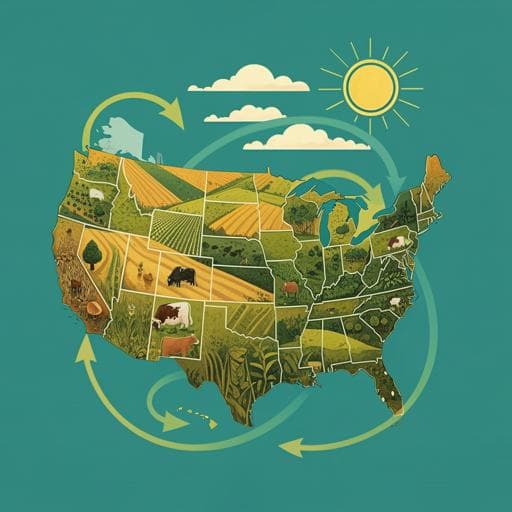
Environmental Studies and Forestry
Greenhouse gas emissions in US beef production can be reduced by up to 30% with the adoption of selected mitigation measures
R. E. O. Pelton, C. E. Kazanski, et al.
This research by Rylie E. O. Pelton and colleagues sheds light on the uneven distribution of greenhouse gas emissions from beef production in the U.S., revealing that up to 30% reduction is possible through targeted practices across regions and supply chain stages. Discover the promising avenues for emission reductions and their potential impacts.
~3 min • Beginner • English
Introduction
The United States is the world’s largest beef producer and fourth largest exporter, producing ~12.3 Mt of beef annually and generating an estimated 201 Mt of GHGs (3.3% of total US emissions) according to prior assessments. Despite historical efficiency gains, prioritizing interventions remains challenging because emissions vary spatially and by production context. The US beef supply chain is complex and largely non-traceable, hindering downstream actors from targeting mitigation effectively. Existing LCA models often aggregate impacts and do not connect subnational commodity flows to spatially explicit environmental impacts, limiting the ability to assess regionally specific reduction potentials. This study addresses these gaps by presenting a spatially explicit, fine-scale cradle-to-gate assessment of GHG impacts and mitigation opportunities across the US beef supply chain, linking spatially determined impacts with a transport cost-minimization model connecting subnational flows of feed and cattle to individual processing facilities. The analysis aims to identify emission hotspots and quantify reduction potentials for individual and combined practices across locations and supply chain stages, providing an upper-end theoretical estimate under ubiquitous adoption assumptions (recognizing that economic and social feasibility constraints require future evaluation).
Literature Review
Prior work shows that beef supply chain emissions vary widely and that enteric fermentation and grazing are major contributors. Existing LCAs often use national averages, aggregate impacts by commodity categories, and lack connection to subnational flows, limiting spatial prioritization of mitigation. Studies comparing grain-finished and grass-finished systems indicate higher emissions associated with grazing and enteric fermentation for grass-based phases. Additional mitigation strategies—such as selective breeding, precision feeding, diet reformulation, vaccines, and multiple feed additives—have been noted in the literature but were beyond the scope of the present analysis. The study builds on supply-chain-aware approaches (e.g., FoodS³) and uses tools like COMET-PLANNER to estimate GHG mitigation/sequestration, noting that estimates vary across sources; when discrepancies arose (e.g., silvopasture), more conservative values were applied.
Methodology
Scope and system boundaries: A spatially explicit, cradle-to-gate life cycle assessment (LCA) was constructed for the US beef supply chain, covering feed crop production (including intermediate feed processing), grazing, feedlot and dairy confinement, animal transport, and beef processing. The LCA quantifies material and energy inputs, emissions (CO₂, CH₄, N₂O), and yields, incorporating spatial variability at the county scale. The analysis considers both emission-reduction practices and land-based carbon sequestration practices.
Supply chain spatialization: The study extends the Food System Supply-Chain Sustainability Model (FoodS³), using linear programming to minimize transport impedance while connecting county- and facility-scale supplies and demands for feed commodities (corn, DDGS, soymeal, wheat/middlings, alfalfa, corn silage, alfalfa hay), grazing-derived cattle (cow-calf, stockers), dairy sources (steers, culled cows), and processing facilities. Data on supplies and demands are primarily from the USDA 2017 Census of Agriculture and slaughter statistics, scaled to commercially slaughtered beef quantities. The model outputs county-to-county flows of commodities and cattle and facility-level sourcing portfolios.
Baseline LCI construction: County-scale average (2007–2017) GHG intensities for feed concentrate ingredients were updated to account for current carbon sequestration from existing cropland conservation (cover cropping, reduced/no till, precision technologies) and expanded to include feed milling and intensively managed pasture systems (synthetic fertilizers), along with spatial estimates for alfalfa, corn silage, and alfalfa hay. Livestock emissions include enteric fermentation (using regionally defined diets/forages from US EPA), manure management by operation and growth phase, and on-farm energy/materials. Processing emissions include facility fuel/electricity use (eGRID regional factors) plus embedded upstream emissions from livestock and feed.
Mitigation scenarios and adoption assumptions: Forty-two mitigation practices across stages were evaluated (Tables 1–3 in the article, with details in Supplementary). Key modeled practices include: crop production (cover crops, conservation tillage, nutrient management/4Rs, irrigation efficiency and variable rate irrigation, renewables for irrigation energy, telemetrics, land use change moratorium); grazing (prescribed grazing, riparian forest restoration, riparian restoration in the Prairie Pothole Region, rangeland planting, silvopasture, adaptive multi-paddock grazing); feedlot/dairy confinement (feed additive 3-NOP for enteric CH₄ reduction; dairy manure solids separation; anaerobic digestion); and processing (energy management: electricity/thermal efficiency, 100% wind electricity). Adoption geographies follow Table 2: e.g., practice application to all eligible lands not yet adopting (cover crops), conversion of intensive/reduced till to no/reduced till, nutrient management in corn where vulnerable, irrigation upgrades where applicable, degraded grazing lands (avg. 61%) for several grazing practices, silvopasture only in historically forested pasturelands excluding riparian buffers, 3-NOP broadly in feedlots/dairy (pending US approval), and manure management upgrades in lagoons/deep pits per current distributions.
Emission and sequestration estimation: County-level reduction potentials largely rely on COMET-PLANNER (DAYCENT-based) for crop and some grazing practices; for practices with conflicting literature (e.g., silvopasture), conservative estimates were used. Short-term sequestration potentials are accounted for and assumed to saturate (e.g., neutralized after 10 years for certain land-based practices) per Supplementary assumptions. Results are aggregated to national totals and mapped to identify hotspots for both absolute reductions and intensity changes.
Impact assessment metrics: GWP100 (IPCC AR5) was used to express CO₂e for CO₂, CH₄, and N₂O, consistent with data vintages in the analysis. Sensitivity to alternative metrics (AR6, GWP20, GTP, GWP*) is discussed as future work.
Computation: Data analysis employed Python (v3.11.2) and Microsoft Excel (v16.65).
Key Findings
Baseline and intensity: The US beef industry baseline totals 257.5 MtCO₂e yr⁻¹ (Table 3 total: 257.512 MtCO₂e), allocated approximately as feed production 15%, grazing 64%, confinement (feedlot + dairy) 19%, and processing 3%. Average emission intensities at the processor gate are about 32.6 kgCO₂e per kg boneless beef for fed-beef, ~30.0 kgCO₂e kg⁻¹ for culled beef, and ~14.5 kgCO₂e kg⁻¹ for culled dairy cows (due to allocation to dairy products). Emissions are spatially heterogeneous: feed and confinement emissions concentrate in the Great Plains and Midwest; grazing emissions are more evenly distributed across the western US; processing emissions cluster around facilities (notably in the Great Plains, with hotspots in the Northeast and Southwest).
Mitigation potential (national): Under ubiquitous adoption of modeled practices, total potential mitigation reaches ~30% of baseline emissions: 8% from direct emission reductions (~20 MtCO₂e yr⁻¹) and 22% from short-term carbon sequestration (~58 MtCO₂e yr⁻¹). Table 3 shows: Total baseline 257.512 MtCO₂e; future emissions with mitigation (emission-reduction only) 237.350 MtCO₂e; short-term sequestration −58.198 MtCO₂e; combined future potential 179.152 MtCO₂e (−30.4%). The largest single short- to medium-term opportunity is silvopasture on eligible grazing lands, reducing cradle-to-gate emissions by 13% (about 20% within the grazing stage) through tree biomass carbon storage.
Stage-specific reductions: • Feed production: stacking practices (e.g., nutrient management/4Rs, cover crops, irrigation efficiency/variable rate, telemetrics, no new LUC) can reduce feed-stage emissions by 54% (≈20.6 MtCO₂e), equating to about 4% of the overall baseline. Table 3 entries: Corn & DDGS baseline 32.824 → 23.530 MtCO₂e (with sequestration −10.143 → 13.387), Soymeal baseline 1.767 → 0.907 (with sequestration −0.325 → 0.582); other feed unchanged. • Grazing: while enteric and manure emissions persist under modeled practices, land-based practices deliver substantial sequestration: pasture category shows −47.730 MtCO₂e short-term sequestration (baseline 3.338 → −44.392 with sequestration). • Feedlot: applying a 3-NOP feed additive reduces feedlot emissions by ~12% (≈4.7 MtCO₂e), targeting enteric methane (baseline feedlot enteric 21.031 → 16.368 MtCO₂e). • Dairy: combining measures (3-NOP, manure management upgrades) could reduce in-stage emissions by ~42% (≈3.5 MtCO₂e). • Processing: energy management (electric and thermal efficiency; 100% wind electricity) can cut processing-stage emissions by ~26% (≈1.8 MtCO₂e).
Spatial hotspots for mitigation: The Northern Great Plains and the southeastern US emerge as hotspots for mitigation, driven by sequestration potential (e.g., riparian restoration in the Prairie Pothole Region; silvopasture in historically forested southeastern pasturelands). Feed-stage mitigation hotspots align with central US feed-sourcing regions (e.g., increased cover crops and nutrient management; irrigation energy efficiency). Confinement-stage opportunities are more uniformly distributed, reflecting similar manure systems and assumed uniform reductions from feed additives.
Additional insights: Emission intensity varies geographically because of animal type/source mixes and processing yields, with some counties specializing in grazing exhibiting higher total emissions, except where large confinement operations dominate. The model underscores that broad adoption across all stages is important, even though the largest potential resides in land-based carbon storage within grazing systems.
Discussion
The study’s spatially explicit cradle-to-gate LCA, integrated with a subnational supply chain optimization, directly addresses the challenge of targeting mitigation in a complex, non-traceable US beef system. By quantifying where emissions occur and where mitigation is most effective, it identifies leverage points across feed production, grazing, confinement, and processing. The findings show that substantial short-term reductions can be achieved via land-based carbon storage (notably silvopasture and riparian-related practices), complemented by direct emission-reduction measures (e.g., nutrient management in crops, 3-NOP in feedlots/dairy, energy management in processing). The results provide a roadmap for processors, retailers, and policymakers to allocate resources to high-impact regions and practices, highlighting the importance of large-scale, cross-stage adoption to approach a 30% sectoral mitigation potential. Importantly, while land-based sequestration drives much of the short-term potential, durable climate progress also requires sustained reductions in emission sources (enteric CH₄, manure CH₄/N₂O, energy-related CO₂). The work demonstrates the value of geospatially resolved LCAs to inform supply-chain climate strategies and underscores that region- and practice-specific conditions must guide implementation to avoid counterproductive outcomes.
Conclusion
This study delivers a fine-scale, spatially explicit cradle-to-gate LCA for the US beef sector, linking county-level environmental impacts with modeled commodity and cattle flows to processing facilities. It identifies a theoretical upper-end mitigation potential of roughly 30% of baseline emissions (≈20 MtCO₂e reductions plus ≈58 MtCO₂e short-term sequestration annually) under ubiquitous adoption of selected practices, with the largest near-term opportunity in grazing land carbon storage (notably silvopasture) and significant additional reductions from crop nutrient management, feedlot/dairy technologies, and processing energy management. The analysis maps hotspots of both emissions and mitigation potential, equipping stakeholders—state and county officials, processors, and producers—with actionable insights for strategic deployment of interventions. Future research should evaluate feasibility constraints, economic and social adoption drivers, long-term permanence of land-based carbon gains, broader enteric mitigation and productivity strategies (e.g., diets, breeding, vaccines, additional additives), potential leakage and rebound effects across supply chains, and alternative climate metrics (AR6, GWP20, GTP, GWP*) to refine prioritization and quantify durable climate benefits.
Limitations
- Adoption feasibility: Results reflect an upper-end potential under ubiquitous adoption; real-world constraints (economic, social, cultural, technical, regulatory) may limit uptake and timing. - Sequestration duration and permanence: Major mitigation stems from short-term land-based carbon sequestration (e.g., assumed to saturate/neutralize after ~10 years in this study); magnitudes and permanence of soil/biomass carbon gains are uncertain and context-dependent. - Scope of practices: The analysis focuses on 42 practices amenable to the modeling framework; other impactful options (e.g., selective breeding, precision feeding, broader diet reformulations, vaccines, additional feed additives) were out of scope. - Data and model uncertainty: Uncertainty exists in inventories, spatial data, emission factors, and sequestration estimates (e.g., COMET-PLANNER vs. literature differences); conservative estimates were used for some practices (e.g., silvopasture). - Metric choice: GWP100 (AR5) was used; adopting AR6 or alternative metrics (GWP20, GTP, GWP*) could alter relative contributions and inferred priorities. - Supply chain assumptions: Lack of traceability necessitated modeled flows; uniform scalars were assumed for some interventions (e.g., feed additive effects), and manure system similarities may mask site-level variability. - Generalizability: Results are US-specific; translating to other countries requires context-specific data and constraints.
Related Publications
Explore these studies to deepen your understanding of the subject.







